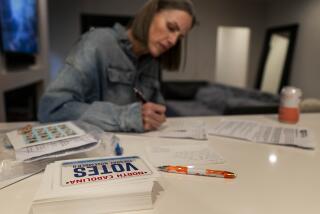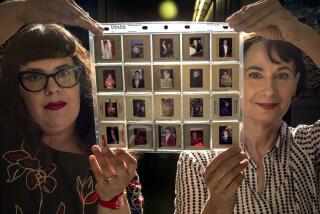Postcards Reflect Past and Present : Collections: More than a million cards are being catalogued at Loyola Marymount University.
- Share via
They don’t make postcards the way they used to. And people don’t write as many interesting things on them these days, either.
Just ask Justine Clancy, who speaks with authority on the subject.
As head of the department of rare books and special collections at Loyola Marymount University, Clancy is in charge of one of the largest postcard collections in existence--more than 1 million of them, dating from the 1860s.
The cards, Clancy said, provide a glimpse into history, and some interesting perspectives on modern times as well.
For example, she said, postcards today tend to show cities in an idealized, cleaned-up condition.
“They are taken on clear beautiful days, without smog,” she said. “The older pictures are usually more honest--they tend to show scenes of how the streets usually looked on a normal day.”
Also, the messages on today’s postcards tend to be a lot less interesting.
“You get a lot of ‘wish you were heres,’ ” Clancy said. “I think it’s because now we don’t always know what to say.”
Among the million or so postcards are nearly 25,000 on Los Angeles, charting the evolution of the city from a Western frontier town to a major metropolitan center, she said.
There are postcards from cities all over the world--not just Paris, France, but Paris, Tex., too.
Most cards depict typical vacation scenes, but some also reflect the pressing issues of the day. A 1908 election postcard shows a Democratic donkey knocking out a Republican elephant (wishful thinking by the Democrats, it turned out--the GOP’s William Howard Taft was elected). Another shows a woman declaring that she wants to be a suffragette.
Among the oldest cards are some of wanted criminals sent to remote post offices in the 1880s.
Not all the cards are made of paper--some are stamped in leather or tin and even grass. A few are hand-painted. A 1950s postcard of Queen Elizabeth II was made in the form of a puzzle.
The collection was donated to the university in 1967 by Werner von Boltenstern, a photographer and world-famous deltiologist--or postcard collector. Boltenstern emigrated from Germany in 1947 and settled in Los Angeles, where he founded the International Postcard Collectors Assn.
After donating his collection to the university, he continued to add to it until his death in 1978.
“The only major condition he made on the gift was that he wanted the entire collection to be kept together,” Clancy said. “If we sold one card, we would have to sell the entire collection.”
The value of the collection has yet to be determined, she said, but some cards could fetch as much as $200. The first postcards date to the mid-1800s when countries agreed to use the postcard as an inexpensive, uniform way to send mail internationally.
Although Loyola’s collection is renowned for its size and quality, most of the cards were simply stashed in boxes until about five years ago, when the university began the laborious process of cataloguing them.
Now, about two-thirds of the cards are catalogued and arranged geographically for the most part. Other categories, such as disasters, art and transportation, are less organized.
“I have never traveled, but the collection has helped me to experience places that I have never seen before,” said Ellen Kinsey, who has helped catalogue many of the cards.
The postcard collection is housed with the rest of the university’s rare book collection, which includes a 1481 edition of Dante’s “The Divine Comedy,” some Shakespeare folios and a first edition of Milton’s “Paradise Lost.”
“People come to see the rare works but they often find themselves browsing through the postcards,” Clancy said.
Many have paid particular interest to the small cities that are included in the collection. There is a picture of the Lutheran church in Fairfax, S.C., for example, and one of a pond at a golf club in St. Albans, N.Y.
“People come in all the time and say, ‘I bet you don’t have a postcard of my hometown,’ ” Clancy said. “They are often surprised at what they find.”


